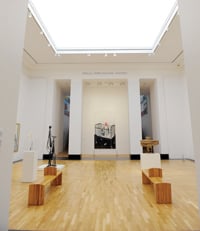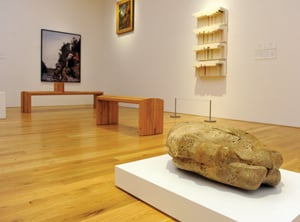Mixed messages
Michael Tooby sets the record straight on the development of new spaces for the contemporary arts in Wales


In July, Amgueddfa Cymru – National Museum Wales completed its refurbishment and conversion of spaces at the National Museum Cardiff. The project integrates its upper floor, now presented as ‘National Museum of Art’. The final element was an additional 750 square metres of new galleries wholly dedicated to modern and contemporary art. The Museum then saw the highest July attendance ever – up by 19% on last year – and positive responses from audiences on the opening displays.
In August, ArtsProfessional ran a report, ‘Capital plans for Wales’, discussing Arts Council Wales’ (ACW) draft capital programme for consultation (AP241). It began: ‘Dreams of a new national gallery for contemporary visual arts in Wales are unlikely to become a reality…’. Referring to the closure of Cardiff’s shortlived Centre for Visual Arts in 2001, it mentions that “subsequent plans for the development for the National Museums and Galleries of Wales failed to prioritise a base for contemporary art”. Given that National Museum of Art is very much a ‘permanent platform for Welsh artists to display their work in an international context’ deemed still missing, I was prompted to reflect.
Amgueddfa Cymru‘s project cost over £6.5m. Not quite 50% came from private donations, bequests and significant grants from Welsh and UK trusts and foundations. Amgueddfa Cymru, like ACW, is supported by the Welsh Government, who provided the balance through significant grants to the project as well as support of continuing operation. ACW was not a funder, so there is no reference to the Museum project in ACW’s document.
The project grew out of a long consultation from 2001 to 2003: ‘Views of the Future’ led by Amgueddfa Cymru, in which ACW were very much involved. This concluded that the future of the visual arts in Wales was not about one location or one institution. Instead it was important to understand the ecology for Wales, for Cardiff as its capital city, and for the diversity of visual arts practice, as well as the viability of potential future development. Key elements were highlighted: the importance of regional venues around the country; the role of digital access to collections; the need to address international touring, curating and collection sharing. Two possible gaps in the infrastructure were identified – investment in a capital city collection-based organisation, and a major new contemporary art facility.
Some of these elements could be addressed by Amgueddfa Cymru, some by ACW, others by collaboration. Amgueddfa Cymru embarked, for example, on a significant programme of collection sharing through projects in partner venues across Wales. Many of these were being refurbished with ACW support. Mostyn in Llandudno, Oriel Davies in Newtown and Ruthin Craft Centre are all examples. These developments nuanced the debate on ‘flagship’ institutions, their Cardiff location and their respective roles. Again, this was not for one organisation to resolve: the resolution for both ‘gaps’ threw up different issues. Amgueddfa Cymru and ACW worked together with an external team on a follow-up options study in 2008 to explore what these were. Two conclusions emerged: Cardiff’s contemporary art venues, from Chapter and g39 to spaces in universities, studio blocks and community venues, do not have spaces like, say, Mostyn. The study addressed the feasibility and potential location of a National Centre for Contemporary Art as a major new presenting ‘gallery’ in south Wales. The then minister, in welcoming the report, concluded that whilst the Welsh Government remained committed to the cultural vibrancy of Wales… “neither Welsh Assembly Government, National Museum, nor Arts Council of Wales have the resources available to forward these projects in the short- to medium-term.”
However, Amgueddfa Cymru, with its world class art collections growing continuously, still lacked adequate display space, particularly for modern and contemporary art. There were immediate possibilities and a long-term project. In the long term, the Museum committed to the principle of a new ‘wing’ to the National Museum for natural history displays, allowing the current site to be a National Gallery, including the presentation of modern and contemporary art. In the short term, the National Museum undertook its National Museum of Art project, now achieved.
So, how does this relate to AP’s article? Some possibilities come to mind. First of all, language. Confusion lies in whether the term ‘gallery’ means the same as ‘museum’. Amgueddfa Cymru’s consultation described a ‘collection-based institution’ precisely because that expresses a particular kind of practice distinct from that connoted by ‘gallery’ or ‘centre’.
Second, collaboration. Arts and cultural organisations operate with shared strategic contexts, even when they have distinct zones of responsibility and spheres of practice. Wales, like other small nations and devolved regions, depends on a collaborative approach to realising projects for the whole nation and the different communities within it. This has proved significant in the development of the visual arts in Wales over the last five to ten years.
Third, first-hand experiences. The distinct experiences offered by regions and nations are not consistently understood further afield. Our visitors and partners know that Wales now has a significant new space for the visual arts, historic, modern and contemporary, whether they think it’s a museum or a gallery. The challenge is how to project that message.
Join the Discussion
You must be logged in to post a comment.